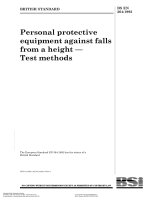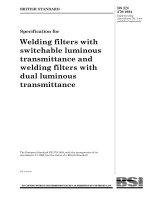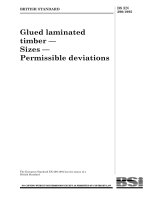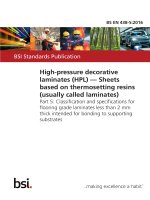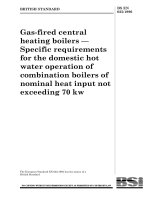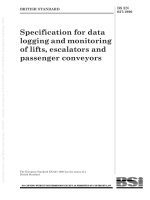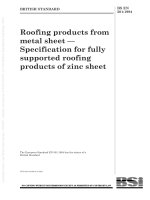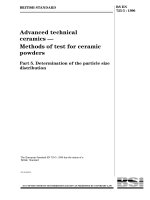Bsi bs en 00635 5 1999
Bạn đang xem bản rút gọn của tài liệu. Xem và tải ngay bản đầy đủ của tài liệu tại đây (123.63 KB, 10 trang )
BRITISH STANDARD
Plywood Ð
Classification by surface
appearance Ð
Part 5: Methods for measuring and
expressing characteristics and defects
The European Standard EN 635-5:1999 has the status of a
British Standard
ICS 79.060.10
NO COPYING WITHOUT BSI PERMISSION EXCEPT AS PERMITTED BY COPYRIGHT LAW
|
|
|
|
|
|
|
|
|
|
|
|
|
|
|
|
|
|
|
|
|
|
|
|
|
|
|
|
|
|
|
|
|
|
|
|
|
|
|
|
|
|
|
|
|
|
|
|
|
|
|
|
|
|
|
|
|
|
|
|
|
|
|
|
|
|
|
|
|
|
|
|
|
|
|
|
|
|
|
|
|
|
|
|
|
|
|
|
|
|
|
|
|
|
|
|
|
|
|
|
|
|
|
|
|
|
|
|
|
|
|
|
|
|
|
|
|
|
|
|
|
|
|
|
|
|
|
|
|
BS EN
635-5:1999
BS EN 635-5:1999
National foreword
This British Standard is the English language version of EN 635-5:1999.
The UK participation in its preparation was entrusted to Technical Committee
B/541, Wood-based panels, which has the responsibility to:
Ð aid enquirers to understand the text;
Ð present to the responsible European committee any enquiries on the
interpretation, or proposals for change, and keep the UK interests informed;
Ð monitor related international and European developments and promulgate
them in the UK.
A list of organizations represented on this committee can be obtained on request to
its secretary.
Cross-references
The British Standards which implement international or European publications
referred to in this document may be found in the BSI Standards Catalogue under the
section entitled ªInternational Standards Correspondence Indexº, or by using the
ªFindº facility of the BSI Standards Electronic Catalogue.
A British Standard does not purport to include all the necessary provisions of a
contract. Users of British Standards are responsible for their correct application.
Compliance with a British Standard does not of itself confer immunity
from legal obligations.
Summary of pages
This document comprises a front cover, an inside front cover, the EN title page,
pages 2 to 6, an inside back cover and a back cover.
The BSI copyright notice displayed throughout this document indicates when the
document was last issued.
This British Standard, having
been prepared under the
direction of the Sector
Committee for Building and Civil
Engineering, was published under
the authority of the Standards
Committee and comes into effect
on 15 August 1999
BSI 08-1999
ISBN 0 580 32361 7
Amendments issued since publication
Amd. No.
Date
Comments
EN 635-5
EUROPEAN STANDARD
NORME EUROPÊENNE
EUROPẰISCHE NORM
March 1999
ICS 79.060.10
English version
Plywood Ð Classification by surface appearance Ð Part 5: Methods
for measuring and expressing characteristics and defects
Contreplaque РClassification selon l'aspect des
faces Ð Partie 5: MeÂthodes de mesure et
d'expression des caracteÂristiques et des deÂfauts
Sperrholz Ð Klassifizierung nach dem Aussehen der
OberflaÈche Ð Teil 5: Meûverfahren und Angabe der
Merkmale und Fehler
This European Standard was approved by CEN on 3 March 1999.
CEN members are bound to comply with the CEN/CENELEC Internal Regulations
which stipulate the conditions for giving this European Standard the status of a
national standard without any alteration. Up-to-date lists and bibliographical
references concerning such national standards may be obtained on application to
the Central Secretariat or to any CEN member.
This European Standard exists in three official versions (English, French, German).
A version in any other language made by translation under the responsibility of a
CEN member into its own language and notified to the Central Secretariat has the
same status as the official versions.
CEN members are the national standards bodies of Austria, Belgium, Czech
Republic, Denmark, Finland, France, Germany, Greece, Iceland, Ireland, Italy,
Luxembourg, Netherlands, Norway, Portugal, Spain, Sweden, Switzerland and
United Kingdom.
CEN
European Committee for Standardization
Comite EuropeÂen de Normalisation
EuropaÈisches Komitee fuÈr Normung
Central Secretariat: rue de Stassart 36, B-1050 Brussels
1999 CEN All rights of exploitation in any form and by any means reserved worldwide for CEN national
Members.
Ref. No. EN 635-5:1999 E
Page 2
EN 635-5:1999
Foreword
This European Standard has been prepared by
Technical Committee CEN/TC 112, Wood-based panels,
the Secretariat of which is held by DIN.
This European Standard shall be given the status of a
national standard, either by publication of an identical
text or by endorsement, at the latest by
September 1999, and conflicting national standards
shall be withdrawn at the latest by September 1999.
According to the CEN/CENELEC Internal Regulations,
the national standards organizations of the following
countries are bound to implement this European
Standard: Austria, Belgium, Czech Republic, Denmark,
Finland, France, Germany, Greece, Iceland, Ireland,
Italy, Luxembourg, Netherlands, Norway, Portugal,
Spain, Sweden, Switzerland and the United Kingdom.
This standard is one of a series of standards for the
classification of plywood by surface appearance.
Contents
Foreword
1
Scope
2
Normative references
3
Definitions
4
Measurements
5
Apparatus
6
Method for measurement
7
Test report
Annex A (informative) Bibliography
Page
2
3
3
3
3
4
4
6
6
BSI 08-1999
Page 3
EN 635-5:1999
1 Scope
3 Definitions
This European Standard specifies the methods for
measuring and expressing:
Ð some inherent characteristics of wood; and
Ð some defects that come from the manufacturing
process
which are used for the classification of the appearance
of plywood surfaces according to EN 635-1, EN 635-2
and EN 635-3.
For the purposes of this standard the definitions of
EN 313-2 and EN 635-1 apply.
2 Normative references
This European Standard incorporates, by dated or
undated reference, provisions from other publications.
These normative references are cited at the
appropriate places in the text and the publications are
listed hereafter. For dated references, subsequent
amendments to or revisions of any of these
publications apply to this European Standard only
when incorporated in it by amendment or revision. For
undated references, the latest edition of the publication
referred to applies.
EN 313-2, Plywood Ð Classification and
terminology Ð Part 2: Terminology.
EN 326-1, Wood-based panels Ð Sampling, cutting and
inspection Ð Part 1: Sampling and cutting of test
pieces and expression of test results.
EN 635-1, Plywood Ð Classification by surface
appearance Ð Part 1: General.
EN 635-2, Plywood Ð Classification by surface
appearance Ð Part 2: Hardwood.
EN 635-3, Plywood Ð Classification by surface
appearance Ð Part 3: Softwood.
4 Measurements
For the purpose of determining the appearance class
of plywood according to EN 635-1, EN 635-2 and
EN 635-3, the following characteristics inherent in
wood (see Table 1) and manufacturing defects (see
Table 2) shall be measured for each surface classified,
according to the methods described in clause 6 of this
standard.
Table 1 Ð Measurements required to classify the characteristics inherent in
wood of plywood surfaces
Category of characteristics
Reference
EN 635-2:1995
EN 635-3:1995
Number
Size
Diameter
Pin knots
3.2.1.1
X
Sound intergrown knots
3.2.1.2
X
X
Unsound or non-adhering knots
and knots holes
3.2.1.3
X
X
Open splits
3.2.1.4
X
Abnormalities due to insects
and marine borers
3.2.1.5
X
Resin pockets and inbark
3.2.1.6
X
Length
Width
X
X
X
X
Area
X
Irregularities in the structure of
the wood, e.g. roughness
3.2.1.7
X
Discolouration which is not
wood destroying
X
BSI 08-1999
3.2.1.8
Page 4
EN 635-5:1999
Table 2 Ð Measurements required to classify the manufacturing defects on plywood surfaces
Category of defects
Reference
EN 635-2:1995
EN 635-3:1995
Number
Size
Diameter
Length
Width
Area
Open joints
3.2.2.1
X
Overlaps
3.2.2.2
X
Hollows, imprints and bumps
3.2.2.4
X
Roughness, other than that due
to irregularities in the structure
of the wood
3.2.2.5
Sanding through
3.2.2.6
X
X
Glue penetration
Repairs
3.2.2.7
3.2.2.9
X
X
X
X
Defects at the edges of the
panel due to sanding or sawing 3.2.2.10
X
5 Apparatus
For measuring the following apparatus is used:
Ð either a metal rule with a graduation of 1 mm;
and
Ð a transparent or semi-transparent film printed
with a rectangular grid; or
Ð any optical system, able to measure the requested
quantities, i.e. lengths, widths, diameters and areas.
6 Methods for measurement
6.1 Quantity in number
Quantities in number of characteristics and defects
shall be related to the full panel surface area (panel
length multiplied by panel width) with the only
exceptions of open splits and open joints, for which
the number shall be related to the panel width.
6.2 Diameter
6.2.1 The measurement shall be expressed to the
nearest millimetre.
6.2.2 The diameter of knots and knot holes shall be
measured as the distance between two opposite
tangents plotted to the circumference of the knot (or
hole) in a direction parallel to the wood fibre direction
of the surface veneer (see Figure 1).
a) Length direction of the panel
Figure 1 Ð Dimensions to be used to
express the diameter (d) of knot holes and
similar characteristics
6.3 Length
6.3.1 The measurement shall be expressed to the
nearest millimetre.
6.3.2 The length of open splits shall be measured and
expressed as the greatest dimension parallel to that of
the wood fibre direction of the surface veneer [see
Figure 2a)].
6.3.3 The length of anomalies due to insects and
marine borers and the length of overlaps shall be
measured and expressed as the maximum dimension,
parallel or perpendicular to the wood fibre direction of
the surface veneer [see Figure 2b)].
BSI 08-1999
Page 5
EN 635-5:1999
6.4.3 The width of abnormalities due to insects and
marine borers shall be measured and expressed as the
minimum dimension either parallel or perpendicular to
the wood fibre direction of the surface veneer [see
Figure 3b)].
6.4.4 The width of open joints, resin pockets and
inbark shall be measured and expressed as the
maximum dimension perpendicular to the length of the
panel [see Figure 3c)].
6.4.5 The width of defects at the edges of the panels
due to sanding and sawing shall be measured and
expressed as the maximum distance between the
referred edge and the parallel tangent line to the defect
[see Figure 3d)].
6.5 Area
a) Length direction of the panel
Figure 2 Ð Dimensions to be used to express
the length (l) of characteristics and defects
6.4 Width
6.4.1 The measurement shall be expressed to the
nearest millimetre.
6.4.2 The width of an open split shall be measured at
the edge of the panel and expressed as the dimension
between two parallels in line with the length of the
panel [see Figure 3a)].
6.5.1 General
The area shall be expressed in square millimetres to
the nearest 5 mm2.
6.5.2 Indirect measurement
The area of the characteristic or defect can be
measured indirectly by tracing its outline onto a
transparent or semi-transparent film which is printed
with a squared grid (see Figure 4).
NOTE The extent of the roughness can be more easily seen and
traced if it is first rubbed with a piece of chalk.
a) Length direction of the panel
Figure 3 Ð Dimensions to be used to express the width (w) of
characteristics and defects
BSI 08-1999
Page 6
EN 635-5:1999
The area shall be determined either by:
6.5.2.1 calculating the area within the trace outline by
counting the number of squares enclosed; or
6.5.2.2 scanning the tracing with suitable electronic
image identification equipment.
Annex A (informative)
Bibliography
ENV 635-4, Plywood Ð Classification by surface
appearance Ð Part 4: Parameters of ability for
finishing Ð Guideline.
6.5.3 Direct measurement
The area of the characteristic or defect can be
measured directly using a suitable electronic image
identification equipment.
Figure 4 Ð Tracing of the outline of a
characteristic or a defect on a
transparent squared grid used to
determine the area
7 Test report
The test report shall be in accordance with EN 326-1
and shall include the following information:
a) the category and type(s) of characteristic and
defect measured;
b) their number, length, width or area as
appropriate;
c) the method used for determination of the
area 6.5.2.1, 6.5.2.2 or 6.5.3.
BSI 08-1999
blank
BS EN
635-5:1999
BSI
389 Chiswick High Road
London
W4 4AL
|
|
|
|
|
|
|
|
|
|
|
|
|
|
|
|
|
|
|
|
|
|
|
|
|
|
|
|
|
|
|
|
|
|
|
|
|
|
|
|
|
|
|
|
|
|
|
|
|
|
|
|
|
|
|
|
|
|
|
|
|
|
|
|
|
|
|
|
|
|
|
|
|
|
|
|
|
|
|
|
|
|
|
|
|
|
|
|
|
|
|
|
|
|
|
|
|
|
|
|
|
|
|
|
|
|
|
|
|
|
|
|
|
|
|
|
|
|
|
|
|
|
|
|
|
|
|
BSI Ð British Standards Institution
BSI is the independent national body responsible for preparing British Standards. It
presents the UK view on standards in Europe and at the international level. It is
incorporated by Royal Charter.
Revisions
British Standards are updated by amendment or revision. Users of British Standards
should make sure that they possess the latest amendments or editions.
It is the constant aim of BSI to improve the quality of our products and services. We
would be grateful if anyone finding an inaccuracy or ambiguity while using this
British Standard would inform the Secretary of the technical committee responsible,
the identity of which can be found on the inside front cover. Tel: 020 8996 9000.
Fax: 020 8996 7400.
BSI offers members an individual updating service called PLUS which ensures that
subscribers automatically receive the latest editions of standards.
Buying standards
Orders for all BSI, international and foreign standards publications should be
addressed to Customer Services. Tel: 020 8996 9001. Fax: 020 8996 7001.
In response to orders for international standards, it is BSI policy to supply the BSI
implementation of those that have been published as British Standards, unless
otherwise requested.
Information on standards
BSI provides a wide range of information on national, European and international
standards through its Library and its Technical Help to Exporters Service. Various
BSI electronic information services are also available which give details on all its
products and services. Contact the Information Centre. Tel: 020 8996 7111.
Fax: 020 8996 7048.
Subscribing members of BSI are kept up to date with standards developments and
receive substantial discounts on the purchase price of standards. For details of
these and other benefits contact Membership Administration. Tel: 020 8996 7002.
Fax: 020 8996 7001.
Copyright
Copyright subsists in all BSI publications. BSI also holds the copyright, in the UK, of
the publications of the international standardization bodies. Except as permitted
under the Copyright, Designs and Patents Act 1988 no extract may be reproduced,
stored in a retrieval system or transmitted in any form or by any means ± electronic,
photocopying, recording or otherwise ± without prior written permission from BSI.
This does not preclude the free use, in the course of implementing the standard, of
necessary details such as symbols, and size, type or grade designations. If these
details are to be used for any other purpose than implementation then the prior
written permission of BSI must be obtained.
If permission is granted, the terms may include royalty payments or a licensing
agreement. Details and advice can be obtained from the Copyright Manager.
Tel: 020 8996 7070.
